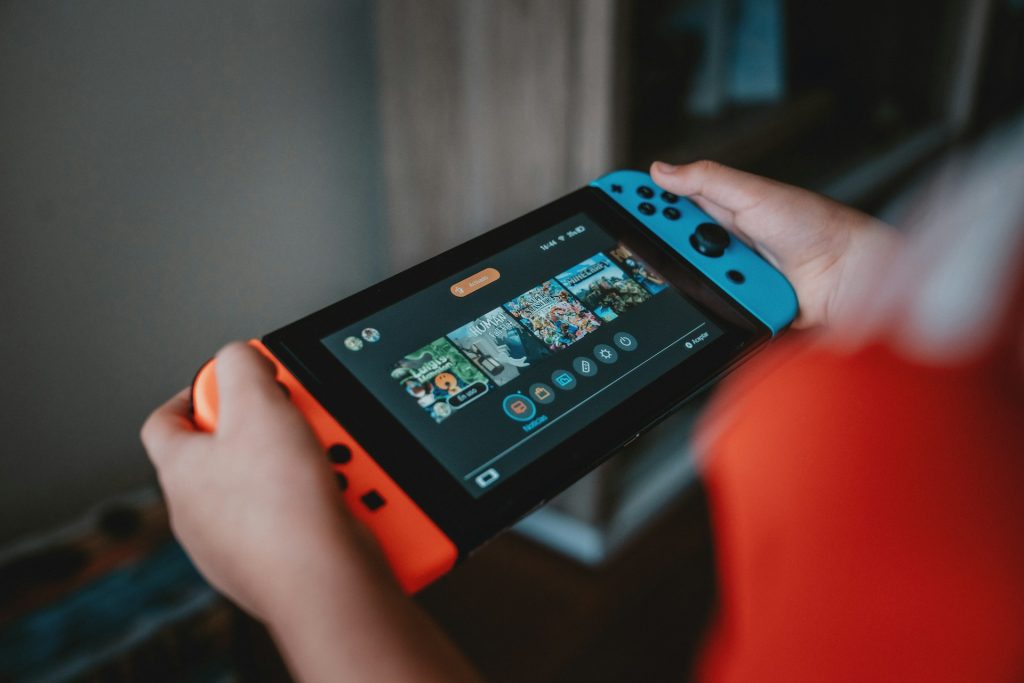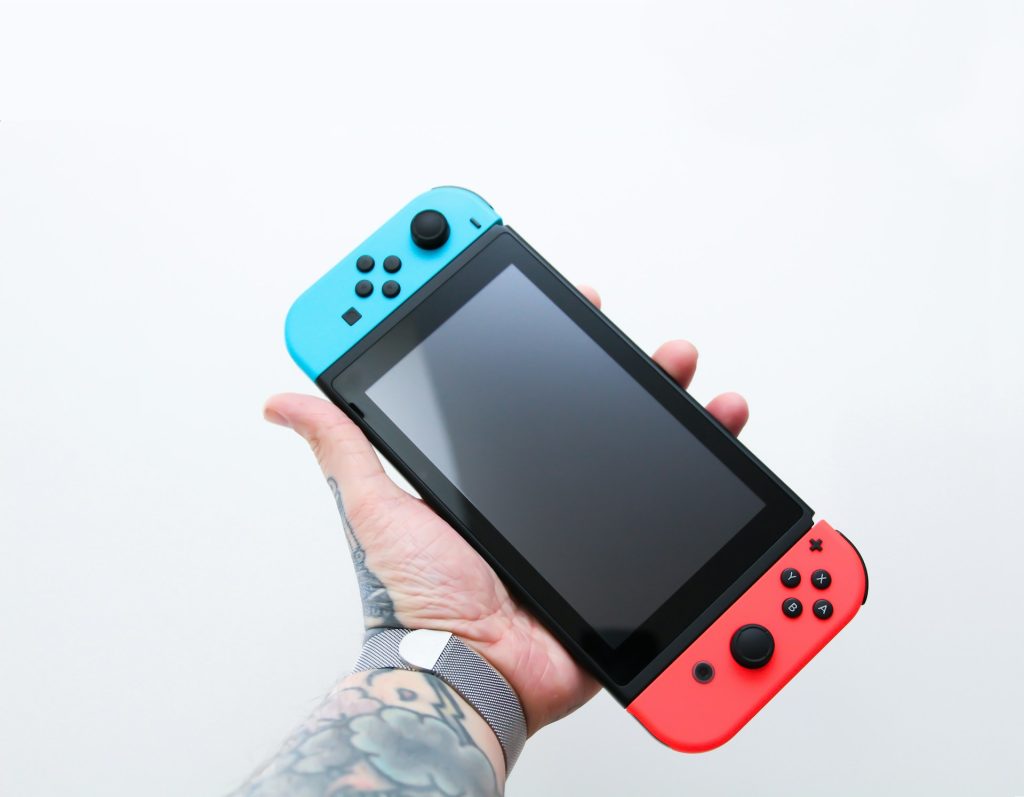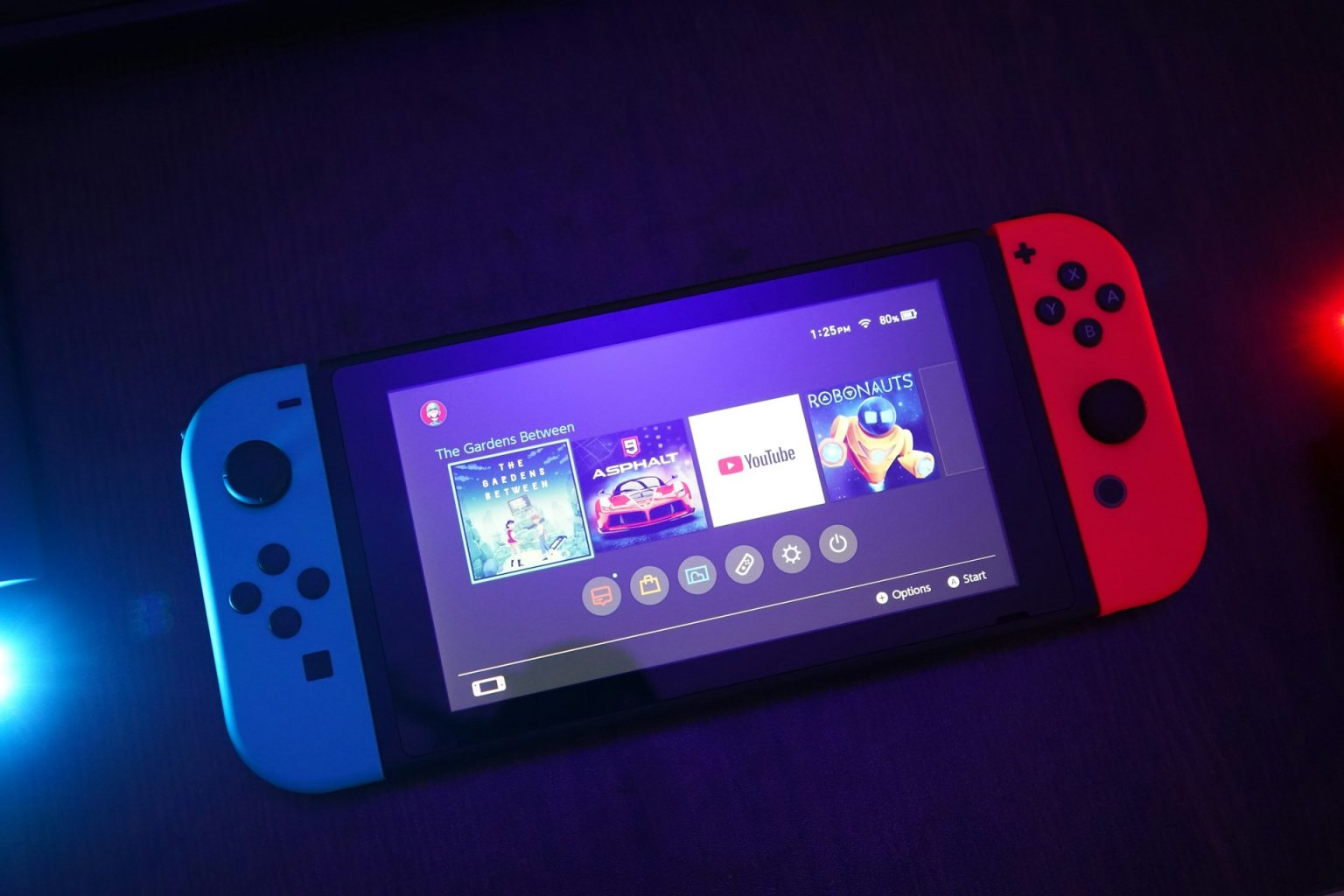The Nintendo Switch is a hybrid video game console developed and released by Nintendo in March 2017. It’s known for its unique design that allows it to function both as a traditional home console and as a portable device, providing flexibility in how and where users can play video games.
The console consists of a tablet-like main unit with a touchscreen, which can be inserted into a docking station to connect to a television for traditional home console gameplay.
It can be removed from the dock and used as a handheld device, making it highly versatile. The Nintendo Switch comes with two detachable controllers called Joy-Cons, which can be used individually or attached to the sides of the main unit for handheld play. These Joy-Cons also feature motion sensing and tactile feedback, adding more depth to the gaming experience.
The Nintendo Switch, celebrated for its adaptability and wide-ranging selection of games, has firmly established itself as a favorite among gaming enthusiasts across the globe. Yet, like any piece of electronic equipment, it’s not without its challenges, overheating being a prominent issue. Such overheating doesn’t just interfere with your gaming experience; it also poses the risk of causing lasting harm to your console.
Reasons Behind Overheating Nintendo Switch and Their Solutions

1. Extended Gameplay Sessions
Reason: Playing on the Nintendo Switch for extended periods without breaks can cause the system to overheat. This is because continuous operation increases the temperature of the internal components, particularly during resource-intensive games that push the hardware to its limits.
Prevention Tip: Implement a habit of taking breaks every hour or so to give your Switch a rest. This can help in managing the system’s temperature and also reduce eye strain and improve the overall gaming experience.
2. Overuse of Wi-Fi
Reason: Continuous Wi-Fi usage, particularly for online gaming or large downloads, demands more from the Nintendo Switch’s processor and networking components, leading to increased heat generation. This is because the system needs to work harder to maintain a stable connection and process incoming data, which in turn, consumes more power and generates more heat.
Prevention Tip: To mitigate this, consider moderating your online gaming sessions and scheduling large downloads for times when the console can be left idle afterward, allowing it to cool down. Also, periodically disconnecting from Wi-Fi when not needed can help reduce the workload on your device and prevent overheating.
3. External Sources of Heat
Reason: External heat sources, such as other electronic devices, direct sunlight, or heaters, can significantly increase the ambient temperature around your Nintendo Switch, contributing to overheating. The console’s internal cooling system is designed to dissipate heat under normal conditions, but external heat sources can overwhelm it, making it less effective.
Prevention Tip: Keep the Nintendo Switch away from windows, radiators, computers, and other electronics that generate heat. Storing and using the console in a cool, shaded area can help maintain optimal operating temperatures and prevent overheating.
4. Incorrect Charging Practices
Reason: Charging habits, like overcharging or playing intensively while the battery is low, can stress the Nintendo Switch’s battery and internal components, leading to excess heat. The device is designed to manage power efficiently, but poor charging practices can compromise this balance.
Prevention Tip: Avoid leaving your Switch plugged in for long periods after it has fully charged, and try not to use it intensively on a low battery. This will help manage the device’s thermal output and ensure the battery remains healthy, reducing overheating risks.
5. Use of Protective Cases
Reason: Protective cases are essential for guarding against physical damage, but some can trap heat around the Nintendo Switch, especially those not designed with ventilation in mind. This insulation effect can hinder heat dissipation, causing the device to overheat during extended use.
Prevention Tip: Opt for protective cases specifically designed for the Switch that feature proper ventilation or are made from heat-dissipating materials. Alternatively, removing the case during prolonged gaming sessions can help prevent overheating by allowing better airflow around the device.
6. Multiplayer on a Single Console
Reason: Engaging in local multiplayer games on a single Nintendo Switch console places additional demand on the system’s hardware. Processing multiple inputs and rendering split-screen visuals can significantly increase the workload, leading to higher heat generation.
Prevention Tip: To prevent overheating during local multiplayer sessions, ensure the console is situated in a well-ventilated area. Additionally, limiting the duration of these sessions and allowing the device to cool down afterward can help manage heat accumulation.
7. Insufficient Rest Between Sessions
Reason: Without adequate downtime between gaming sessions, the Nintendo Switch may not have sufficient opportunity to cool down, leading to accumulated heat stress on the system. Continuous operation without breaks exacerbates heat buildup, which can degrade internal components over time.
Prevention Tip: Allowing your Switch to rest and cool down between extended play sessions can significantly reduce the risk of overheating. Implementing a routine that includes regular breaks will give the console time to return to a normal temperature, preserving its longevity.
8. Use in Docked Mode with Poor Ventilation
Reason: When the Nintendo Switch is used in docked mode, the confined space around the dock can restrict airflow, especially if it’s placed in an area with poor ventilation. This restriction can impede the console’s ability to dissipate heat, causing it to overheat more quickly than when used in handheld mode.
Prevention Tip: Place the dock in an open area with ample airflow. Consider a setup that allows for at least a few inches of space around each side of the dock to ensure proper air circulation. For enhanced cooling, docks with built-in fans or external cooling solutions can further reduce overheating risks.
9. Heavy Download Sessions
Reason: Downloading large files or performing multiple downloads in succession can keep the Nintendo Switch’s CPU and network chip active for extended periods, generating additional heat. The sustained data transfer and processing required for these activities can cause the device to overheat if not managed properly.
Prevention Tip: Schedule heavy download tasks overnight or when the console will not be in use immediately afterward. This strategy allows the Switch to handle downloads at a time when it can be left idle, reducing heat generation and allowing any accumulated heat to dissipate more effectively.

10. Running High-Performance Games Without Breaks
Reason: High-performance games that leverage the full capabilities of the Nintendo Switch’s hardware can cause the system to generate significant amounts of heat. Without breaks, the continuous demand on the processor and graphics unit exacerbates heat buildup, risking overheating.
Prevention Tip: Take regular breaks when playing graphically intensive or high-performance games. This not only helps in managing the console’s temperature but also contributes to a healthier gaming habit. Implementing a break every hour or so allows the system to cool down, preventing overheating.
11. Ignoring System Warnings
Reason: The Nintendo Switch is equipped with internal sensors designed to monitor its operating temperature. When it gets too hot, the system will display warnings indicating that it’s overheating. Ignoring these warnings and continuing to use the console can lead to serious damage.
Prevention Tip: Always pay attention to any system warnings related to temperature. If your Switch indicates it’s overheating, turn it off and move it to a cooler location immediately. Allowing the device to cool down before resuming play can prevent damage and ensure the longevity of your console.
12. Inadequate Ventilation
Reason: The Nintendo Switch relies on its built-in ventilation system to cool down. If these vents are blocked or restricted, the heat generated by the console cannot dissipate effectively, leading to overheating.
Prevention Tip: Always ensure that the console’s air vents are clear of obstructions. When using the Switch in handheld mode, be mindful of how you hold it, and when docked, ensure the dock is in a well-ventilated area.
13. High Ambient Temperature
Reason: Operating the Switch in environments with high ambient temperatures can contribute to overheating. The console’s internal cooling mechanisms are less effective in hot conditions, as the air used for cooling is already warm.
Prevention Tip: Use your Switch in cooler environments whenever possible. If you’re in a hot climate, playing in air-conditioned rooms or using a fan can help maintain a lower ambient temperature around your device.
14. Running Demanding Games
Reason: Certain games require more processing power from the Switch’s CPU and GPU, leading to increased heat production. Graphically intensive games or those with complex physics can strain the system, causing it to overheat.
Prevention Tip: Be aware of the demands of your games. For those who are particularly taxing on the system, consider limiting playtime to one session and ensure your device has time to cool down afterward.
15. Software Issues
Reason: Software glitches or outdated system firmware can cause the Switch to overheat. These issues might prevent the system from managing its resources efficiently, leading to unnecessary strain and heat buildup.
Prevention Tip: Keep your Nintendo Switch firmware updated. Nintendo regularly releases updates that can fix bugs and improve system efficiency, potentially reducing overheating issues.
16. Charging While Playing
Reason: The battery generates heat when charging, and using the Switch while it’s charging compounds the heat generation, especially during gameplay, which can lead to overheating.
Prevention Tip: Try to avoid playing on your Switch while it’s charging. If you must play while charging, ensure the device is in a well-ventilated area to help dissipate heat.
17. Faulty Battery
Reason: A malfunctioning or damaged battery can overheat by itself and also cause the Nintendo Switch to overheat. This is due to the battery not operating within its normal parameters, leading to excessive heat generation.
Prevention Tip: Regularly monitor your Switch’s battery health and look out for signs of malfunction, such as rapid drainage or the console getting unusually hot. Contact Nintendo support for a replacement if you suspect battery issues.
18. Dust and Debris
Reason: Accumulation of dust and debris in the Switch’s air vents can obstruct airflow, making it harder for the console to cool itself effectively and leading to overheating.
Prevention Tip: Clean the air vents of your Switch regularly using compressed air. This can help maintain proper airflow and prevent overheating caused by blockages.
19. Improper Storage
Reason: Storing the Switch in areas with poor ventilation or high temperatures, such as a car under direct sunlight or a closed cabinet, can cause the device to overheat even when not in use.
Prevention Tip: Store your Switch in a cool, ventilated place away from direct sunlight. Avoid leaving it in hot cars or enclosed spaces where heat can accumulate.
20. Using Non-Official Chargers
Reason: Third-party chargers may not meet the Nintendo Switch’s specifications and can deliver the wrong voltage or amperage, causing the device to overheat during charging.
Prevention Tip: Always use the official Nintendo charger or certified third-party chargers that meet Nintendo’s specifications to ensure safe and efficient charging.
21. Screen Brightness
Reason: Higher screen brightness settings require more power, which can lead to increased heat generation within the Switch, especially during lengthy gaming sessions.
Prevention Tip: Lower the screen brightness to a comfortable level that doesn’t strain your eyes, especially in darker environments, to help reduce heat production.
22. Background Applications
Reason: Having multiple applications running in the background can cause the Nintendo Switch’s processor to work harder, which generates additional heat.
Prevention Tip: Close any unnecessary applications running in the background to reduce the strain on the processor and help keep the device cool.
23. Hardware Malfunction
Reason: Internal hardware issues, such as a failing fan or malfunctioning components, can prevent the Switch from cooling properly, leading to overheating.
Prevention Tip: If you suspect a hardware malfunction, especially if your Switch is overheating without a clear external cause, contact Nintendo support for diagnostic and repair services.
24. Docked Mode
Reason: The Nintendo Switch can run hotter in docked mode due to higher performance demands and potential restrictions in airflow around the dock, especially if it’s placed in an enclosed space.
Prevention Tip: Ensure your dock is in an open area with good ventilation. Avoid placing it inside cabinets or other enclosed spaces where heat can build up.
25. Poor Maintenance
Reason: Lack of regular maintenance, such as not cleaning the air vents or ignoring software updates, can lead to inefficiencies in the system that cause overheating.
Prevention Tip: Perform regular maintenance on your Switch, including software updates and cleaning, to ensure it operates efficiently and stays cool.

